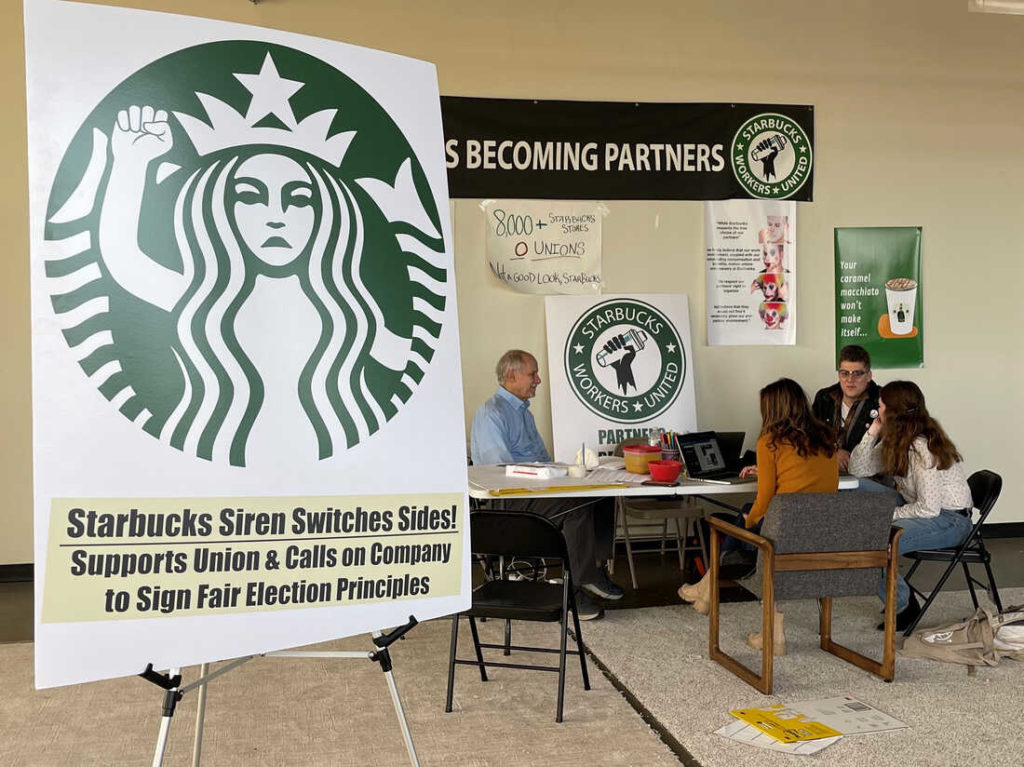The Pandemic and the Starbucks Union Drive

The Starbucks union drive continues to advance by leaps and bounds, with multiple stores per day voting for a union. One reason is the company’s indifference to the pandemic, which really ticked off workers who didn’t want to die to serve a grande vanilla latte with soy milk and extra hot to people driving through in their Escalades.
For Meridian, 17, a trans nonbinary person from Virginia seeking their first job, their interest in Starbucks went beyond salary or benefits. “I live in a very rural town,” they explained to me. “I thought, what is an environment that I want to be in, in this very small-town job? And Starbucks appealed to me because they seemed like a very progressive company and I thought I would be in good company there.”
Workers, when asked, say they enjoy the work. The environment Starbucks tries to cultivate and the values it espouses bring in a certain type of employee. “Starbucks attracts a lot of progressive-minded people,” said Cory Johnson, 28, who works at the Boulevard and Myers Starbucks in Richmond, Virginia. “People who are either doing some kind of activism or organizing outside of work.” Co-workers throughout interviews for this piece referred to each other as “family.”
But when the COVID-19 pandemic began, many of the elements that created this progressive, community-oriented atmosphere disappeared, as face-to-face interactions with customers were now considered a health risk. Cafés shut down, leaving transactions to the drive-through window, as well as new demand from an old source: mobile ordering.
This shift is one of the quiet reasons why we’ve seen over two dozen Starbucks stores unionize over the past couple of months, with hundreds more potentially on the way. The pandemic exacerbated long-standing problems that had damaged Starbucks’s relationship with its workers, and those workers had the organizing chops to address those problems through collective action.
BEFORE THE PANDEMIC, restaurants were integrating software between the front of house, the kitchen, and the supply chain to make the industry “more efficient.” Every food service sector worker knows the peril of “the schedule”: whether or not they will get enough hours to pay the bills this week.
Early on in the pandemic, mobile ordering became the primary way customers would get their coffees and muffins at Starbucks. Restrictions were placed on how many people could be in a given space, which reduced available employees. And the new phenomenon of online ordering became add-on work for current staff. “I would describe it as [like] a lot of food service jobs,” said Johnson. “Making sure there’s less people on the floor doing the work, but putting more work on the people who are on the floor doing it.”
Initially, workers received 30 days’ “distress pay.” But as the pandemic went on, restrictions were eased, and more people became comfortable being around others again, the distress pay faded as mobile ordering remained, increasing the workload. In addition, Johnson noted, “we simply do not have the people to keep up with the demand.” Employment in leisure and hospitality is still 1.5 million short of where it was in February 2020, according to the Bureau of Labor Statistics. It has been hard to find workers to cope with the increase in responsibilities.
This is all super interesting. I will also note that this reinforces my analysis that the current wave of unionization is quite specifically in performatively liberal companies. Note how the person at the beginning of the story talks about the company and why they wanted to work there. It performs progressive and then treats workers like garbage. This is just opening the door to unions. And workers are kicking that door wide open.


